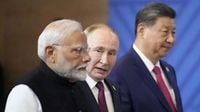The recent denial of shore leave to a Russian naval training vessel in Cape Town has thrust South Africa’s foreign policy and its commitment to the BRICS bloc under the spotlight, revealing the complex web of domestic and international pressures shaping the nation’s diplomatic path. The incident, which occurred on August 5, 2025, when The Smolny docked at Cape Town harbour, went largely unnoticed at first. Only on August 8, just as the ship prepared to depart, did the South African Border Management Authority confirm that disembarkation had been refused, an act that broke with years of routine protocol. According to Russian sources cited by IOL, cadets with military IDs had never before been refused shore leave in South Africa, with visas typically granted on arrival.
This sudden change, coming amid escalating U.S. tariffs on South Africa, has fueled speculation about the true motives behind the decision. Was it a simple bureaucratic hiccup, or, as many suspect, a calculated signal sent under pressure from Washington? The three days of official silence that followed the vessel’s arrival only deepened suspicions. For some, the episode is emblematic of a broader geopolitical struggle—one in which South Africa, as a member of BRICS, finds itself caught between competing allegiances to the United States and its Western allies, and to its historical partners in Russia and China.
South Africa’s role within BRICS—a bloc originally formed in 2006 by Brazil, Russia, India, and China, with South Africa joining in 2010—has always been fraught with tension. The alliance, which has since expanded to include Egypt, Iran, Ethiopia, the United Arab Emirates, and, as of 2025, Indonesia, was envisioned as a counterweight to Western economic dominance and as a platform for non-European countries to deepen economic ties and challenge the supremacy of the U.S. dollar. Yet, as detailed in a recent commentary on IOL, internal divisions, corruption, and continued dependence on Western markets have hampered BRICS’s effectiveness. The most recent BRICS summit, held on July 6-7, 2025, was described as a “big circus” that achieved little of substance. Russia’s President Vladimir Putin participated only by video, wary of international arrest warrants, while China’s Xi Jinping skipped the event entirely, reportedly viewing it as a waste of time.
During the summit, Indian Prime Minister Narendra Modi and Brazil’s President Lula da Silva were vocal in their criticism of Western nations’ indifference to the challenges facing the developing world—climate change, economic inequality, health crises, poverty, and the destruction of tropical forests. According to the commentary, “there is a truth in these assertions,” yet the author notes a deep irony: despite their rhetoric, BRICS leaders, including those from China and Russia, have themselves been accused of corruption, power consolidation, and human rights abuses. “Leaders and influential people from all of the BRICS countries including China have deposited billions of dollars in Swiss and other offshore banks,” the article claims, adding that intra-BRICS trade remains stagnant while members continue to do more business with the West than with each other.
For South Africa, these contradictions are compounded by domestic political dynamics. The Democratic Alliance (DA), long seen as the standard-bearer for liberal, Western-aligned policies, has been accused by critics of acting as a local proxy for U.S. and European interests. The DA’s support for punitive U.S. tariffs on South Africa—and its alignment with AfriForum in welcoming these measures—has only reinforced perceptions of its loyalty to the “unilateral white supremacist order,” as described by political commentator Sipho Singiswa in IOL. The DA’s actions, Singiswa argues, are not incidental but part of a broader Western strategy to keep the Global South “compliant, and its resources accessible.”
This tension reached a fever pitch on May 21, 2025, when former U.S. President Donald Trump summoned South African President Cyril Ramaphosa to the Oval Office. There, Trump reportedly repeated the discredited claim of a “white farmer genocide” in South Africa and demanded that Ramaphosa bring along white South Africans handpicked by Trump himself. According to IOL, these individuals were used as political props to pressure Ramaphosa into abandoning land reform, severing ties with Russia and China, and even withdrawing from BRICS. The Trump administration’s hostility toward South Africa’s support for Palestine and its ties to Russia, China, and Iran has been explicit, with Washington pushing for Pretoria to drop its genocide case against Israel at the International Court of Justice.
Corporate interests have further muddied the waters. Sibanye Stillwater, a mining company with deep U.S. links, lobbied Trump to impose anti-dumping duties on Russian palladium and urged Ramaphosa to grant U.S. firms preferential access to South Africa’s mineral wealth. Neal Froneman, Sibanye’s CEO, and Rick Menell, a board member, reportedly pitched the idea of using South Africa as a springboard for U.S. access to Africa’s rare mineral reserves, according to IOL. The confluence of political and business pressure from the West has left South Africa’s foreign policy vulnerable to outside influence, critics say.
Meanwhile, the African National Congress (ANC), which has historically maintained close ties with Russia and China, finds itself hamstrung by policy ambiguity and internal divisions. Its wavering positions on trade, land reform, and restorative justice have created a vacuum that Western-aligned actors, including the DA, have been quick to exploit. The result, Singiswa contends, is a situation in which South Africa’s sovereignty and BRICS commitments are routinely undermined by “quiet acts of subservience, procedural decisions, withheld permissions and diplomatic silences.”
The July BRICS summit laid bare many of the alliance’s fundamental weaknesses. Despite talk of creating a non-dollar currency, the reality is that BRICS members do more business with Western countries than with each other, and many have vast reserves stashed in offshore banks. The commentary notes that “if BRICS want to stay relevant and to have global impact and are serious in peace, BRICS should implement” reforms such as demanding an end to Russia’s military actions in Ukraine and Africa, reducing authoritarianism, halting aggressive policies, and boosting intra-BRICS trade. Yet, skepticism abounds. “It is understandable that most BRICS members, such as Russia, China and Iran will not take any of the above steps,” the author concludes, suggesting that without meaningful change, BRICS risks becoming little more than an annual “big Tamasha without any real results.”
The Smolny incident, then, is more than a minor diplomatic spat—it is a symbol of the broader contest for South Africa’s allegiance and the future of BRICS itself. As geopolitical tensions escalate, the country’s leaders face mounting pressure to choose between the promises of a multipolar world and the realities of Western economic and political dominance. For now, the silence that followed the Russian vessel’s denial of shore leave may speak louder than any official statement, hinting at the quiet but profound influence of foreign agendas on South Africa’s sovereignty and its place on the world stage.
In the end, the fate of South Africa’s BRICS commitments—and its ability to chart an independent course—may rest not in grand declarations, but in the everyday decisions made behind closed doors, far from the glare of public scrutiny.

